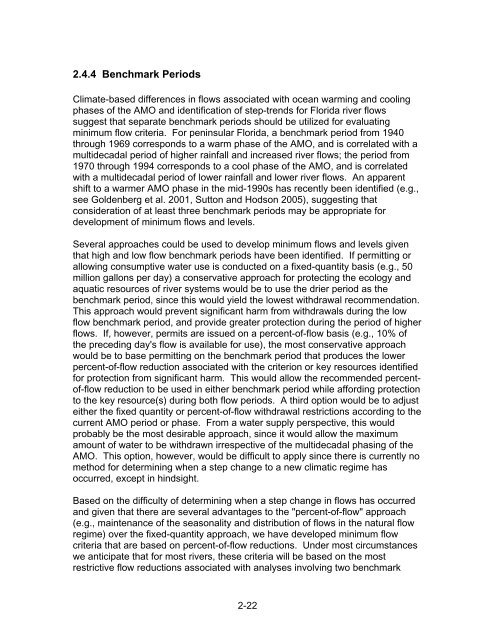Chapter 1 Minimum Flows and Levels - Southwest Florida Water ...
Chapter 1 Minimum Flows and Levels - Southwest Florida Water ...
Chapter 1 Minimum Flows and Levels - Southwest Florida Water ...
You also want an ePaper? Increase the reach of your titles
YUMPU automatically turns print PDFs into web optimized ePapers that Google loves.
2.4.4 Benchmark Periods<br />
Climate-based differences in flows associated with ocean warming <strong>and</strong> cooling<br />
phases of the AMO <strong>and</strong> identification of step-trends for <strong>Florida</strong> river flows<br />
suggest that separate benchmark periods should be utilized for evaluating<br />
minimum flow criteria. For peninsular <strong>Florida</strong>, a benchmark period from 1940<br />
through 1969 corresponds to a warm phase of the AMO, <strong>and</strong> is correlated with a<br />
multidecadal period of higher rainfall <strong>and</strong> increased river flows; the period from<br />
1970 through 1994 corresponds to a cool phase of the AMO, <strong>and</strong> is correlated<br />
with a multidecadal period of lower rainfall <strong>and</strong> lower river flows. An apparent<br />
shift to a warmer AMO phase in the mid-1990s has recently been identified (e.g.,<br />
see Goldenberg et al. 2001, Sutton <strong>and</strong> Hodson 2005), suggesting that<br />
consideration of at least three benchmark periods may be appropriate for<br />
development of minimum flows <strong>and</strong> levels.<br />
Several approaches could be used to develop minimum flows <strong>and</strong> levels given<br />
that high <strong>and</strong> low flow benchmark periods have been identified. If permitting or<br />
allowing consumptive water use is conducted on a fixed-quantity basis (e.g., 50<br />
million gallons per day) a conservative approach for protecting the ecology <strong>and</strong><br />
aquatic resources of river systems would be to use the drier period as the<br />
benchmark period, since this would yield the lowest withdrawal recommendation.<br />
This approach would prevent significant harm from withdrawals during the low<br />
flow benchmark period, <strong>and</strong> provide greater protection during the period of higher<br />
flows. If, however, permits are issued on a percent-of-flow basis (e.g., 10% of<br />
the preceding day's flow is available for use), the most conservative approach<br />
would be to base permitting on the benchmark period that produces the lower<br />
percent-of-flow reduction associated with the criterion or key resources identified<br />
for protection from significant harm. This would allow the recommended percentof-flow<br />
reduction to be used in either benchmark period while affording protection<br />
to the key resource(s) during both flow periods. A third option would be to adjust<br />
either the fixed quantity or percent-of-flow withdrawal restrictions according to the<br />
current AMO period or phase. From a water supply perspective, this would<br />
probably be the most desirable approach, since it would allow the maximum<br />
amount of water to be withdrawn irrespective of the multidecadal phasing of the<br />
AMO. This option, however, would be difficult to apply since there is currently no<br />
method for determining when a step change to a new climatic regime has<br />
occurred, except in hindsight.<br />
Based on the difficulty of determining when a step change in flows has occurred<br />
<strong>and</strong> given that there are several advantages to the "percent-of-flow" approach<br />
(e.g., maintenance of the seasonality <strong>and</strong> distribution of flows in the natural flow<br />
regime) over the fixed-quantity approach, we have developed minimum flow<br />
criteria that are based on percent-of-flow reductions. Under most circumstances<br />
we anticipate that for most rivers, these criteria will be based on the most<br />
restrictive flow reductions associated with analyses involving two benchmark<br />
2-22
















